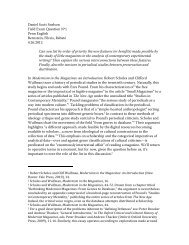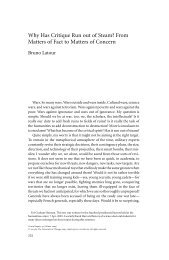The Exploit: A Theory of Networks - asounder
The Exploit: A Theory of Networks - asounder
The Exploit: A Theory of Networks - asounder
You also want an ePaper? Increase the reach of your titles
YUMPU automatically turns print PDFs into web optimized ePapers that Google loves.
Edges 129<br />
role <strong>of</strong> medicine is to restore balance. By contrast, a qualitative concept<br />
<strong>of</strong> illness (represented by Leriche’s medical research) suggests<br />
that disease is a qualitatively different state than health, a different<br />
mode <strong>of</strong> biological being altogether. <strong>The</strong> experience <strong>of</strong> disease involving<br />
pain, fevers, and nausea is an indicator <strong>of</strong> a wholly different<br />
mode <strong>of</strong> biological being, not simply a greater or lesser state <strong>of</strong> balance.<br />
In this case, medicine’s role is to treat the symptoms as the disease<br />
itself.<br />
However, it is the third and last transition in concepts <strong>of</strong> illness<br />
that is the most telling—what Canguilhem calls “disease as error.”<br />
Molecular genetics and biochemistry configure disease as an error in<br />
the genetic code, an error in the function <strong>of</strong> the program <strong>of</strong> the organism.<br />
This is the current hope behind research into the genetic mechanisms<br />
<strong>of</strong> a range <strong>of</strong> diseases and disorders from diabetes to cancer.<br />
But what this requires is another kind <strong>of</strong> medical hermeneutics, one<br />
very different from the patient’s testimony <strong>of</strong> the Hippocratic and<br />
Galenic traditions, and one very different from the semiotic approach<br />
<strong>of</strong> eighteenth - century pathological anatomy (where lesions on the<br />
tissues are signs or traces <strong>of</strong> disease). <strong>The</strong> kind <strong>of</strong> medical hermeneutics<br />
required is more akin to a kind <strong>of</strong> occult cryptography, a deciphering<br />
<strong>of</strong> secret messages in genetic codes. Disease expresses itself not via<br />
the patient’s testimony, not via the signs <strong>of</strong> the body’s surfaces, but via a<br />
code that is a kind <strong>of</strong> key or cipher. <strong>The</strong> hope is that the TP53 gene is a<br />
cipher to the occulted book <strong>of</strong> cancerous metastases, and so on. <strong>The</strong><br />
“disease itself ” is everywhere and nowhere—it is clearly immanent<br />
to the organism, the body, the patient, but precisely because <strong>of</strong> this<br />
immanence, it cannot be located, localized, or contained (and certainly<br />
not in single genes that “cause” disease). Instead disease is an<br />
informatic expression, both immanent and manifest, that must be<br />
mapped and decoded.<br />
<strong>The</strong> Paranormal and the Pathological II<br />
One habitually associates epidemics with disease, and disease with<br />
death. And for good reason; experience <strong>of</strong>ten shows the link between<br />
disease and death, or at least between disease and a falling - away from









